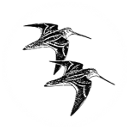Recent activities

Common Crane – April 2014
Notes by Alan Harris on two Common Cranes at Amwell NR, 27 April 2014 10:55am, then Rye Meads 11:00 -11:10am.
Two cranes flew in from the north. I first noted them over the Bittern pool/Holycross Lake from the Gladwin hide, flying at a height of around 120 feet, directly toward me. I momentarily thought they were herons coming back to the heronry but they were flying too close together and the wing beats/shape weren’t right. I immediately realised that they were Common Cranes and raised the alarm to the rest of my family.
The dark outer wing and silvery white coverts were obvious head on. The cranes flew directly down the Great Hardmead Lake and continued southwards until they were lost to view in Rye Meads airspace. At the highpoint several birders obviously saw the birds simultaneously to me (including John Bartlett, and William Bishop who notified Phil Ball (who was oblivious to the drama, staring glumly out of the White hide) by impressive good old fashioned bellowing across the water. I could see them all pointing; it was like a Hitler youth rally up there (without the youth bit obviously… er… or Hitler).
By the time the cranes were halfway down the pit we were already trying to raise birders at Rye Meads on the phone (once again via Sarah Harris, this time in Norfolk! Last time it was a White Stork on April Fools day – she coordinated the Herts twitch from the Isle of Skye, as always, immensely jealous!). The cranes landed in the 2nd (north) meadow at Rye Meads for a few minutes (seen by Toby Spall who, having been given the heads up, had raced up from the south lagoons, ever more desperately searching the sky, before a last resort scan of the meadows from the Lapwing hide brought him salvation, and let’s face it, he deserves it). Just as he had located them from the empty hide they took off and flew south directly over the RSPB visitor centre at about pylon height, calling, to the immense relief of Jim Redwood who had just arrived.
Both birds were massive even compared to a heron, long black legs and long neck held straight out. The flight action was languid yet direct, the birds rose and fell smoothly along their flight path, the wing tips flexed up and down in a deliberate, firm action with each stroke, the outer primaries separated as fingers. The body was rounded and heavy looking. They were dark grey, with the upper wing coverts silvery and pale, the flight feathers blackish. The neck had a white strip down the side from above the eye, the face and throat was black, the cap was red. The bill was fairly short. Surprisingly no other sightings have been posted of their journey south after Rye Meads.
